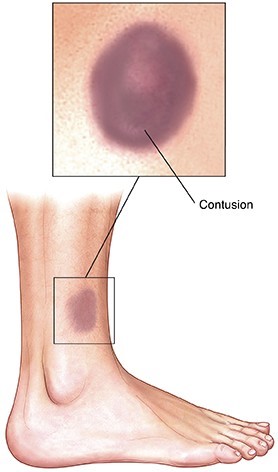A client comes to the emergency department complaining of localized pain and swelling of his lower leg. Ecchymotic areas are noted. History reveals that the client got bit in the leg with a baseball bat. Which of the following would the nurse suspect as most likely?
Strain.
Sprain.
Contusion.
Fracture.
The Correct Answer is C
Contusion. The nurse would suspect a contusion as the client was hit by a baseball bat and has localized pain and swelling with ecchymosis (bruising).

Option A, Strain, is unlikely as a strain is a stretching or tearing of a muscle or tendon, and it is not usually caused by blunt force trauma.
Option B, Sprain, is unlikely as a sprain is a stretching or tearing of a ligament, and it is not usually caused by blunt force trauma.
Option D, Fracture, is unlikely as a fracture is a break in the bone and usually involves more severe pain and may be accompanied by deformity.
Nursing Test Bank
Naxlex Comprehensive Predictor Exams
Related Questions
Correct Answer is C
Explanation
Allow the client to follow your lead. This technique would be most beneficial for the ambulation of a visually impaired client. The nurse should allow the client to follow their lead because they are more familiar with their surroundings and can navigate better.
Option A, speaking before touching the client, is appropriate but not as effective as allowing the client to follow the nurse's lead.
Option B, providing a see-eye guide dog, may not always be feasible.
Option D, providing a detailed description of the room and walkway, may be helpful but not as effective as allowing the client to follow the nurse's lead.
Correct Answer is A
Explanation
Giving non-prescription laxatives to a client with cirrhosis can cause severe dehydration and electrolyte imbalances, which can be life-threatening. The nurse should report this intervention immediately to the physician.
Choice B is incorrect because measuring abdominal girth is a standard nursing intervention for clients with cirrhosis to assess for ascites.
Choice C is incorrect because asking the client about food intake is a standard nursing intervention for assessing nutritional status.
Choice D is incorrect because checking for signs of hepatic encephalopathy is a standard nursing intervention for clients with cirrhosis.
Whether you are a student looking to ace your exams or a practicing nurse seeking to enhance your expertise , our nursing education contents will empower you with the confidence and competence to make a difference in the lives of patients and become a respected leader in the healthcare field.
Visit Naxlex, invest in your future and unlock endless possibilities with our unparalleled nursing education contents today
Report Wrong Answer on the Current Question
Do you disagree with the answer? If yes, what is your expected answer? Explain.
Kindly be descriptive with the issue you are facing.
